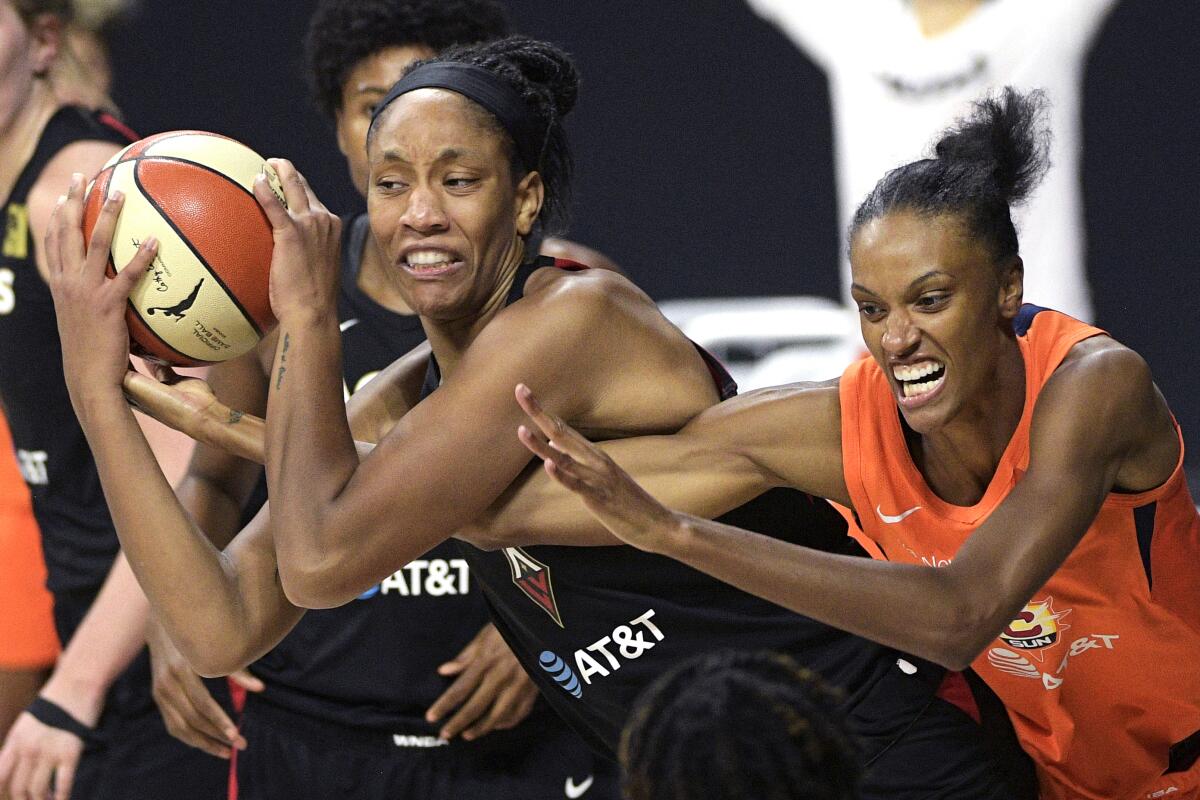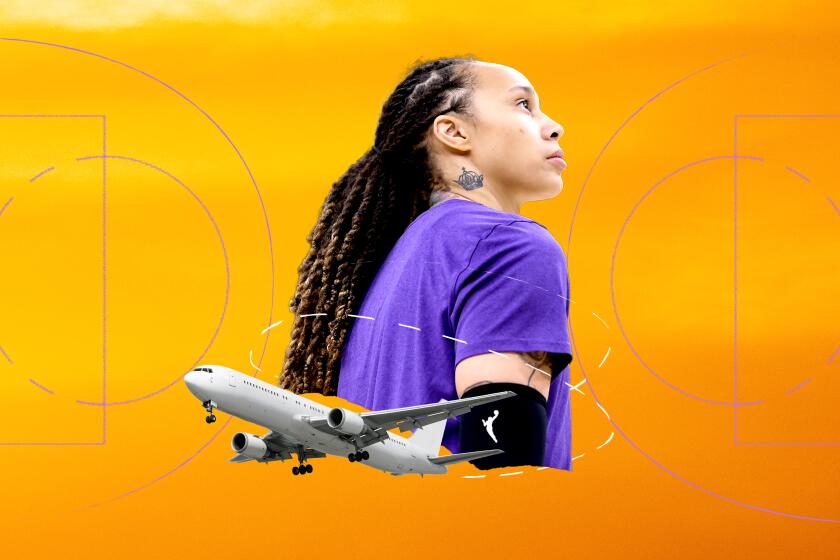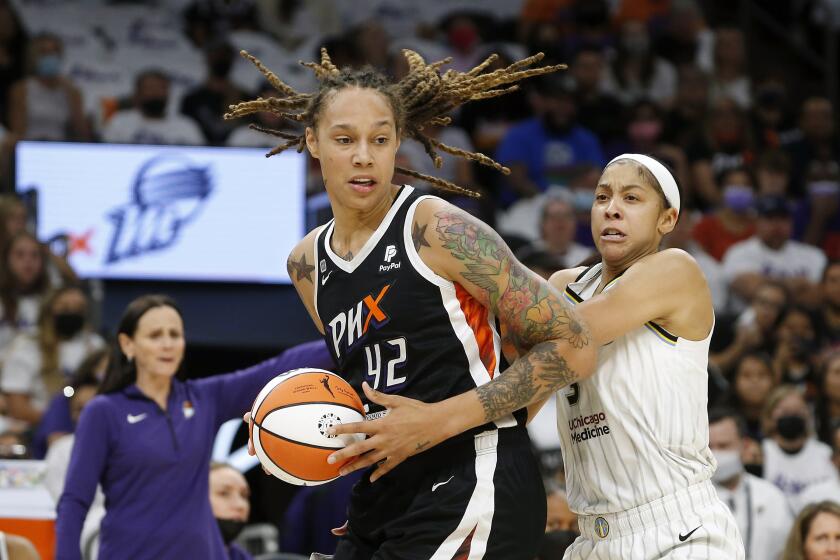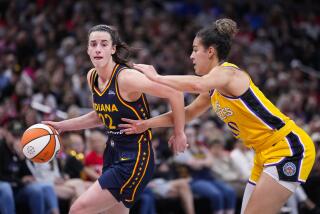Is the WNBA witnessing the big breakthrough it’s been waiting for?

- Share via
It’s the matchup that WNBA fans predicted. The league’s two super teams, the Las Vegas Aces and the New York Liberty, and arguably its biggest players in A’ja Wilson and Breanna Stewart are pitted against each other in the WNBA Finals starting Sunday.
In other words, it’s a potential broadcast ratings gold mine.
That’s good news for the WNBA, which is coming off its most-watched season in 21 years. The ratings boost is likely to make the league’s media rights negotiations in 2025 its highest-stakes deal yet. With the option for players to opt out of the collective bargaining agreement looming next year and expansion on the horizon, the high viewership numbers are a linchpin for charting the WNBA’s financial future.
“We increase viewership, that helps lead to more sponsors and advertising, it’ll put us in a stronger position as we head into negotiating our next round of media rights deals,” WNBA commissioner Cathy Engelbert said. “And that’s what leads to revenue ... and then we can invest that in the players and to grow the league even more.”
The WNBA did just that Thursday, announcing with the Golden State Warriors that the Bay Area will be home to the 13th WNBA franchise starting in 2025. The new team will practice in Oakland at the Warriors facility and play games at Chase Center in San Francisco.
Engelbert said the Bay Area’s strong support for women’s college basketball, including powerhouse Stanford, its status as a top media market and the region’s tech dominance were primary reasons the WNBA chose it for its first expansion team since 2008.
“It is really important that you’re bringing in long-term owners committed to the success not just of the team and winning championships, but to the league overall,” Engelbert told reporters Thursday. “This gives us ... a big media market, a big place where I think our players are going to want to live and work.”
Players have called for expansion for years, hoping to capitalize on the growth of the women’s college game feeding stars to the professional ranks. After the NCAA women’s basketball tournament set viewership records this year, the WNBA followed suit.
The WNBA‘s viewership across ABC, ESPN, ESPN2 and CBS was up 21% compared to last season, according to the league. This year’s All-Star Game was the WNBA’s most watched in 16 years with about 850,000 viewers tuning in.
WNBA players’ push to add charter flights is getting amplified by Brittney Griner’s inability to take commercial flights after her Russian detention.
Even on a crowded NFL Sunday, Game 4 of the semifinals between the Liberty and Connecticut Sun was the most-watched WNBA playoff game this season with 579,000 average viewers on ABC and a peak viewership of more than 920,000, according to ESPN.
“The relationship between the perception of a business and its ongoing sustainability, it is very much tied to fan engagement,” said Donna Orender, president of the WNBA from 2005 to 2010. “Viewership is a big part of fan engagement.”
Fans also flocked to games in person, boosting attendance 16% compared to the previous year, according to the WNBA. More than 1.5 million fans attended games, the most in 13 years. The average game attendance was about 6,600, the most since 2018.
The WNBA’s diverse viewership also is valuable to advertisers. During the 2021 and 2022 playoffs, more Black households were watching, as well as households with incomes ranging from $150,000 to $200,000, according to television data firm Samba TV. The WNBA also is starting to attract viewers age 20 to 24, Samba reported.
Add the fact that 80% of consumer purchasing decisions in the U.S. are made or influenced by a woman, Engelbert said, and the league is hopeful that broadcasters and sponsors are seeing the WNBA’s value.
“I never want someone just to support us because they think it’s the right thing to do,” Engelbert said. “It’s also a good business decision because we are a legitimate sports media and entertainment growth property.”
Viewership has been growing since 2020, when the pandemic scrambled sports broadcasts and provided an opportunity for women’s leagues to gain traction on broadcast networks, said Ceyda Mumcu, chair of the sport management department at the University of New Haven.
“We have been saying, ‘Put us on television. If you put us on television, and you tell our fans how to watch, then they’ll find the games and they will watch,’” said Terri Jackson, executive director of the WNBA’s players union. “We all know everyone was at home in 2020 looking for something to watch, and these players did not disappoint.”
The WNBA is looking to increase revenues through a mixture of sponsorships and marketing so players like Brittney Griner don’t have to go overseas.
Capitalizing on the success after the pandemic, the WNBA raised $75 million in its first-ever round of funding and used the money from more than two dozen investors to fuel digital transformation, marketing and globalization of the game, Engelbert said. The rewards showed in the higher viewership numbers.
“The trajectory of all the metrics for the W and, I really think, for women’s sports generally are undeniable,” said Atlanta Dream managing partner Larry Gottesdiener, who is part of the ownership group that took over the team in 2021. “Women’s sports is having a moment, and my advice to fellow investors would be to invest early, invest for the long term, and fortunes are gonna be made.”
In addition to the Bay Area’s new team, a 14th franchise also will start play in 2025. Engelbert cited Sacramento, Portland, Toronto, Charlotte, Philadelphia and Denver as cities she has visited or spoken with. It’s the first time the WNBA has expanded since the Dream joined the league 15 years ago.
While the league celebrates opening the path to more viewers and increased advertising appeal, players are keeping an eye on smaller ways the WNBA can grow. Aces star Kelsey Plum, who is first vice president of the players union, previously cautioned against expanding before increasing salaries or making greater progress on key issues like providing more charter flights.
“I don’t know how I feel about expansion, to be honest,” she told reporters at an All-Star Game news conference in July. “I feel like we have some holes that we can work on currently. And we can do a better job of figuring out ways to fix some of the current issues that we have.”
The WNBA has been expanding the number of games for which teams are allowed to charter flights, including providing them for all postseason games this year. But there are limits.
The Sparks saw this firsthand in August, when the team faced an overnight delay in Washington during a three-game trip. At the time, Sparks guard Layshia Clarendon said players were “unfortunately used to it. Key word, unfortunately.”
“We’re always kind of reminding the league, ‘This is not helping us be better athletes, better products for you on the floor,’” Clarendon said. “Travel’s travel, life’s going to happen with commercial flights, but just working with us to make sure there’s a better way to deal with those hiccups.”
After crafting a successful blueprint for women’s soccer, the NWSL finds itself shut out of the Women’s World Cup amid the worldwide growth of the sport.
The 2020 CBA that was hailed as “groundbreaking” for its steep salary raises and comprehensive family planning benefits addressed some travel concerns. Players were guaranteed individual hotel rooms and at least economy-plus seats on all flights for the eight-season deal. With the possibility of opting out by Nov. 1, 2024, players could use the soaring TV ratings as leverage for an improved deal.
“These are things that are in high consideration when you want to see changes in the future,” said Nneka Ogwumike, the Sparks’ star forward and president of the players union.
Sports business experts say the league is on a growth trajectory. They point to attendance and revenue for the NBA’s first few decades and note the WNBA is in a similar place.
Many businesses, and especially sports leagues, have a history of relatively lean beginnings, hopeful expectations and then cycles of business growth or decline before emerging as “the sustainable behemoths that we see today,” said Orender, the former WNBA president.
“And even then,” she said, “it’s a hard business.”
More to Read
Go beyond the scoreboard
Get the latest on L.A.'s teams in the daily Sports Report newsletter.
You may occasionally receive promotional content from the Los Angeles Times.















